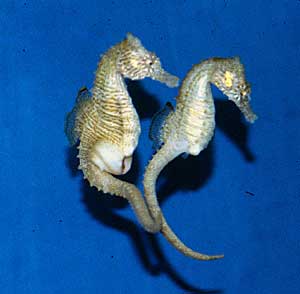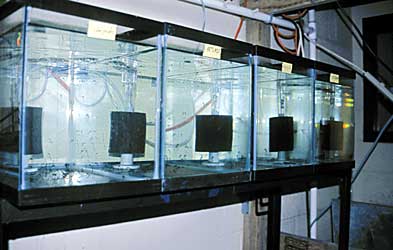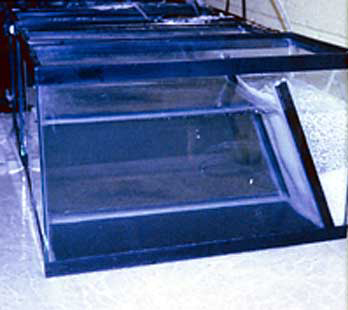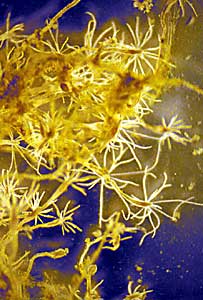|  More
than 20 million seahorses are traded worldwide each year and
there is every indication that seahorse sales are on the rise.
Although the vast majority of these are destined for use in
Chinese traditional medicine, substantial numbers are also
taken for the aquarium trade and shell shops. Seahorses' low
fecundity, monogamous mating behavior, and limited species
ranges, place them in a precarious ecological position. The
sustainability of this fishery has not been fully determined,
but it is very likely being exceeded for many species. More
than 20 million seahorses are traded worldwide each year and
there is every indication that seahorse sales are on the rise.
Although the vast majority of these are destined for use in
Chinese traditional medicine, substantial numbers are also
taken for the aquarium trade and shell shops. Seahorses' low
fecundity, monogamous mating behavior, and limited species
ranges, place them in a precarious ecological position. The
sustainability of this fishery has not been fully determined,
but it is very likely being exceeded for many species.
Although seahorses have been spawned and reared in captivity
for many years, a simple, effective, and reliable culture
protocol is still sorely needed. Many articles to date document
overly complex rearing systems or lack essential details to
protect a commercial interest on the part of the author. Large-scale
aquaculture operations with high-tech systems may relieve
some of the stresses placed on wild populations, however many
of the species most at risk of over-harvesting are collected
by subsistence fishermen in island nations such as Indonesia
and the Philippines where the latest aquaculture technology
may not be an option. Project Seahorse has organized an initiative
to teach aquaculture methods to these fishermen, but technology
remains a problem. The development of rearing techniques utilizing
simple, inexpensive equipment would be in the best interest
of these indigenous peoples and the wild seahorse stocks being
exploited. It would also be helpful for the home hobbyist
who would love to raise the young seahorses inevitably produced
as a result of good seahorse husbandry, without spending a
small fortune. The purpose of this article is to report on
my preliminary rearing trials and the solutions to some of
the problems I have encountered.
At the Hofstra University Aquaculture Laboratory in Hempstead,
NY an effort is underway to solve some of the problems preventing
efficient seahorse culture. Two of the major stumbling blocks
encountered in the rearing stage are: the inability to provide
a sufficiently nutritious first food, and an apparent gas
bladder problem that can afflict more than 50% of a brood
within the first few days. The affected juveniles become trapped
at the surface and eventually die.
Newborn seahorses will only eat live food, and, to date,
Artemia has been the most popular choice in culture
attempts because of its availability and convenience. Unfortunately,
Artemia are separated from ocean food webs by several
million years of evolution. So it should come as no surprise
that marine organisms are not well adapted to digesting them
and utilizing their nutrients. Copepods, on the other hand,
are probably the most abundant multicellular organisms in
the oceans and are heavily exploited by innumerable marine
species. In aquaculture, they have proven time after time
to be nutritionally superior to Artemia as a food source
for larval and juvenile marine fishes. It is generally accepted
that the reason for this is related to the levels and proportions
of highly unsaturated fatty acids (HUFAs) in copepods versus
Artemia. Eicosapentaenoic acid (EPA) and docosahexaenoic
acid (DHA) are of particular importance. A number of enriching
products are available that can be used to enhance the nutritional
value of Artemia. Most of these products attempt to
impart a fatty acid profile similar to that of a copepod.
Unfortunately the use of these products still has not achieved
the success provided by copepods in terms of growth, survival,
and overall health of cultured fishes. The problem with copepods
is that, in spite of their abundance, we have not yet developed
a technique to culture them in high enough densities to make
their use economically viable. Some researchers and aquaculturists
have resorted to catching wild copepods for use in fish rearing,
however this can be labor-intensive and cost-prohibitive.
It can also introduce parasites and fouling organisms into
the rearing system. In the 1970s, using wild plankton (dominated
by copepods), Moe and Young became the first and only people
to rear larvae of the French angelfish (Pomacanthus paru),
successfully. Amazingly, in spite of raising thousands of
them, they were unable to turn a profit, partially because
of the cost of obtaining sufficient numbers of copepods.
A detailed experiment, aimed at examining the copepod/Artemia
trade-off in seahorse culture has been designed and will be
conducted at the Hofstra University Aquaculture lab over the
next few months. To date, three preliminary rearing trials
have taken place. The purpose of these trials was to investigate
some feeding regimes and filtration designs that might ultimately
be used in the experiment.
Four pairs of adult Hippocampus erectus were collected off
Long Island, New York, and housed in a 55- gallon aquarium.
Filtration consisted of a power head-driven undergravel filter
with 2 inches of crushed coral, and an Ehiem canister filter
with activated carbon and nitrate sponge from Kent Marine.
The broodstock was fed four times per day with frozen mysids
(Mysis relicta) and chopped shore shrimp (Palaemonetes
pugio). A light timer provided a 15-hour light photoperiod.
Courtship behavior was observed virtually every morning, but
will not be discussed here. Receptive males indicate their
readiness to spawn with a swollen pouch. Actual copulation
was rarely observed, but if the same male was seen with a
swollen pouch for more than 3 days, he was considered to be
pregnant and placed in a rearing tank. Occasionally the pouch
would be deflated a few hours later, but most of the time
this criterion indicated an actual pregnancy.

All rearing trials were conducted in standard 10-gallon tanks,
each with an entire brood of Hippocampus erectus.
In trials 1 and 2, small air driven foam filters were used.
In trial 3, one end of the tank was sectioned off with a Penn
Plax tank divider. A piece of 500-micron nylon screen was
used in place of the plastic divider insert. The divider was
placed at an angle of approximately 30° to the end of
the tank.

The resulting compartment was filled with small plastic
beads, which were slightly negatively buoyant. The beads were
kept in motion with aeration, forming a simple fluidized bed
filter. In this tank, an 8-inch air diffuser was placed on
the floor of the tank, at the end with the filter compartment
to prevent seahorses from being drawn into the netting. This
method of aeration created a vertical circulation pattern
in the tank that kept most of the newborn seahorses from becoming
caught on the surface of the water, as was experienced in
trials 1 and 2. In each trial, live Isochrysis galbana
was maintained at a density sufficient to keep a 2-cm secchi
disk out of sight at a distance of 50 cm. All tank bottoms
were siphoned daily. In the first trial, nauplii of Artemia
salina, enriched with Super HUFA (Salt Creek, Inc.) were
offered as the exclusive food. After 2 weeks 100% mortality
was observed in this tank. In the second trial, copepod-dominated
wild plankton (CDWP) was substituted as a live food for the
first 2 weeks, after which time the diet was abruptly switched
to enriched Artemia salina. At the end of the 60-day
trial, 190 seahorses were counted. In the third trial CDWP
was offered for only 3 days, followed by enriched nauplii
of Artemia franciscanis. After 60 days, 214 seahorses
were counted and moved into a 40-gallon grow-out tank. Food
densities were maintained at 0.5-2/ml. Synthetic seawater
in all broodstock, rearing, growout and plankton culture tanks
was maintained at 25ppt with Instant Ocean synthetic sea salt.
Artemia cysts were decapsulated with household bleach
(5.25% Sodium Hypochlorite). Isochrysis was cultured
according to the methods outlined in the Plankton Culture
Manual by Hoff and Snell.
Obviously these preliminary trials do not represent controlled
experiments. Percent survival could not be calculated or even
estimated for trials 2 and 3 because the initial brood size
was not counted. All that can be said is that copepods appear
to play a crucial role in the early diet of H. erectus.
The controlled experiments planned for the coming months are
aimed at determining the effects of variations of the copepod/Artemia
feeding regime during the first week, on the growth and survival
of H. erectus after one month. The results of these
experiments will be discussed in a future Sea Scope article.
 Although
I have not had a problem with parasites associated with the
use of wild plankton, a number of other pests were introduced
to the tanks along with the desirable plankton. The worst
of these were hydroids, gammarid amphipods, and gastrotrichs.
Hydroids were probably introduced as larvae or medusae. Within
a few days of introduction, fuzzy colonies could be seen on
the walls of the tank. Their stinging tentacles can injure
and even kill small seahorses, but they probably do more damage
by competing for food. By the time a hydroid colony reaches
a few inches in diameter, it can become a serious drain on
your plankton supply. Three hydroid genera have been observed
in our aquaria: Bouganvillia, Tubularia,
and one other, which has not yet been identified. Scraping
the colonies off the walls only helps temporarily. Within
a few days, numerous new colonies are formed around the tank
as a result of fragmentation. Although
I have not had a problem with parasites associated with the
use of wild plankton, a number of other pests were introduced
to the tanks along with the desirable plankton. The worst
of these were hydroids, gammarid amphipods, and gastrotrichs.
Hydroids were probably introduced as larvae or medusae. Within
a few days of introduction, fuzzy colonies could be seen on
the walls of the tank. Their stinging tentacles can injure
and even kill small seahorses, but they probably do more damage
by competing for food. By the time a hydroid colony reaches
a few inches in diameter, it can become a serious drain on
your plankton supply. Three hydroid genera have been observed
in our aquaria: Bouganvillia, Tubularia,
and one other, which has not yet been identified. Scraping
the colonies off the walls only helps temporarily. Within
a few days, numerous new colonies are formed around the tank
as a result of fragmentation.
In an attempt to learn more about these hydroids, we began
culturing them in separate tanks. After a few weeks of culturing,
a tiny nudibranch, identified as Tenellia fuscata, appeared
in some of the hydroid tanks. White egg clusters also appeared
among the hydroid tentacles. The 6-mm nudibranchs were observed
feeding on the tentacles of all three hydroid species. Within
about a month of their initial appearance, hundreds of nudibranchs
could be seen in these tanks and virtually all of the hydroids
had been consumed. Hydroid-eating nudibranchs such as Tenellia
have appendages called cerata on their backs. As they feed
on their cnidarian (corals, anemones, hydroids and jellyfishes)
hosts, they are able to keep the cnidocytes (stinging cells
found in cnidarian tentacles) intact. They transfer the cnidocytes
into their cerata to sting would-be predators that dare to
bite into them. Hopefully, with the help of T. fuscata,
hydroids will no longer be a problem in our rearing tanks.
The amphipods came in as small but fast-growing juveniles.
Although they are an important component of the seahorses'
diet in the wild, in a culture tank they will quickly grow
too large for a young seahorse to ingest and are very competitive
planktivores. Siphoning seems to be the best technique for
removing amphipods. Once removed they can be used as a nutritious,
live treat for adult seahorses.
Gastrotrichs are an obscure phylum of free-living worm-like
organisms that normally live interstitially in sediment. I
have often seen large populations of an unidentified gastrotrich
crawling on the skin of young seahorses that have been exposed
to wild plankton. I don't believe that the gastrotrichs are
parasitizing the seahorses, but they do appear to be a source
of stress as they stimulate incessant scratching. They can
be removed with a fresh-water bath.
If you are interested in keeping and/or breeding seahorses,
I encourage you to take some time to research their requirements
before making a purchase. In many respects seahorses are hardy
fishes, however they have a number of unique needs that must
be met if they are to survive and thrive in the home aquarium.
One of the most important of these is the need to be in a
non-competitive environment. The sad fact is that the vast
majority of fishes in the trade will not be suitable tank-mates
for seahorses. You should also make every attempt to acquire
captive-bred seahorses as these will be well adapted to aquarium
life and will not have been subjected to many of the diseases
and other stresses that contribute to the high mortality rate
of wild-caught animals.
For more information, you can log on to
www.seahorse.org where you will find a community of hobbyists
and professionals dedicated to responsible seahorse husbandry,
breeding, and conservation.
|

